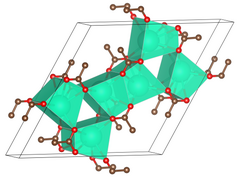Caesium acetate: Difference between revisions
Appearance
Content deleted Content added
Gehenna1510 (talk | contribs) m fixed ref |
Narky Blert (talk | contribs) Link to DAB page repaired |
||
| Line 53: | Line 53: | ||
}} |
}} |
||
'''Caesium acetate''' or '''cesium acetate''' is an [[ion]]ic [[caesium]] compound with the molecular formula CH<sub>3</sub>CO<sub>2</sub>Cs. It is often used in organic synthesis especially in [[Perkin synthesis]]: the formation of [[ |
'''Caesium acetate''' or '''cesium acetate''' is an [[ion]]ic [[caesium]] compound with the molecular formula CH<sub>3</sub>CO<sub>2</sub>Cs. It is often used in organic synthesis especially in [[Perkin synthesis]]: the formation of [[Saturated and unsaturated compounds|unsaturated]] [[cinnamic acid|cinnamic-type acids]] by the condensation of aromatic [[aldehyde]]s with [[fatty acid]]s.<ref>{{citation | first1 = E. | last1 = Koepp | first2 = F. | last2 = Vögtle | title = Perkin-Synthese mit Cäsiumacetat | journal = Synthesis | volume = 1987 | issue = 2 | year = 1987 | pages = 177–179 | doi = 10.1055/s-1987-27880}}.</ref> |
||
It may be formed by the reaction of [[caesium hydroxide]] or [[caesium oxide|caesium]] carbonate with [[acetic acid]]. Caesium acetate is occasionally used instead of caesium formate in petroleum drilling fluids.{{cn|date=October 2013}} |
It may be formed by the reaction of [[caesium hydroxide]] or [[caesium oxide|caesium]] carbonate with [[acetic acid]]. Caesium acetate is occasionally used instead of caesium formate in petroleum drilling fluids.{{cn|date=October 2013}} |
||
Revision as of 09:54, 7 February 2020
 Structural formula
| |
 Unit cell of water-free caesium acetate.
| |
| Names | |
|---|---|
| IUPAC name
Caesium acetate
| |
| Other names
Cesium acetate
| |
| Identifiers | |
3D model (JSmol)
|
|
| ChemSpider | |
| ECHA InfoCard | 100.020.226 |
PubChem CID
|
|
CompTox Dashboard (EPA)
|
|
| |
| |
| Properties | |
| C2H3CsO2 | |
| Molar mass | 191.949 g/mol |
| Appearance | colourless, hygroscopic |
| Density | 2.423 g/cm3, solid |
| Melting point | 194 °C (381 °F; 467 K) |
| Boiling point | 945 °C (1,733 °F; 1,218 K) |
| 945.1 g/100 g (−2.5 °C) 1345.5 g/100 ml (88.5 °C) | |
| Structure[2] | |
| Primitve hexagonal | |
| P6/m, No. 175 | |
a = 1488.0 pm, c = 397.65 pm[2]
| |
Lattice volume (V)
|
76.542 cm3·mol−1 |
Formula units (Z)
|
6 |
| Hazards | |
| Flash point | Non-flammable |
| Related compounds | |
Other anions
|
Caesium formate |
Other cations
|
Lithium acetate Sodium acetate Potassium acetate Rubidium acetate |
Except where otherwise noted, data are given for materials in their standard state (at 25 °C [77 °F], 100 kPa).
| |
Caesium acetate or cesium acetate is an ionic caesium compound with the molecular formula CH3CO2Cs. It is often used in organic synthesis especially in Perkin synthesis: the formation of unsaturated cinnamic-type acids by the condensation of aromatic aldehydes with fatty acids.[3]
It may be formed by the reaction of caesium hydroxide or caesium carbonate with acetic acid. Caesium acetate is occasionally used instead of caesium formate in petroleum drilling fluids.[citation needed]
References
- ^ Weast, Robert C., ed. (1981). CRC Handbook of Chemistry and Physics (62nd ed.). Boca Raton, FL: CRC Press. p. B-91. ISBN 0-8493-0462-8..
- ^ a b Lossin, Adalbert; Meyer, Gerd (1993). "Kristallstruktur von Caesiumacetat, Cs(CH3COO)". Zeitschrift für Anorganische und Allgemeine Chemie. 619 (8): 1462–1464. doi:10.1002/zaac.19936190823.
- ^ Koepp, E.; Vögtle, F. (1987), "Perkin-Synthese mit Cäsiumacetat", Synthesis, 1987 (2): 177–179, doi:10.1055/s-1987-27880.
Further reading
- Torisawa, Yasuhiro; Okabe, Hiromitsu; Ikegami, Shiro (1984), "Efficient Inversions of Secondary Alcohols using Cesium Acetate and 18-Crown-6", Chem. Lett., 13 (9): 1555–56, doi:10.1246/cl.1984.1555.
